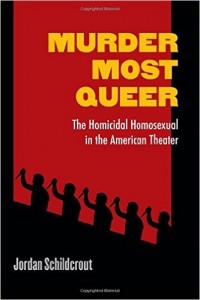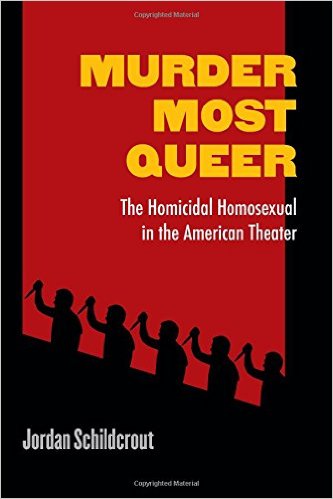 Murder Most Queer: The Homicidal
Murder Most Queer: The Homicidal
Homosexual in the American Theater
by Jordan Schildcrout
University of Michigan Press
268 pages, $34.50
VIOLENT GAY CHARACTERS have a long tradition in American theater. Their presence reflects both the homophobia of the era in which they flourished and the growing awareness of gay people as a social reality. It’s easy to dismiss these figures today as horrible relics of an earlier time. But there might be more going on in these characters and the plots they inhabit than we assume, for both the playwrights who created them and the audiences who came to watch.
Such is the premise of Jordan Schildcrout’s original, well-researched, and immensely readable book.
Beginning with Mae West’s melodrama The Drag (1927), Schildcrout situates the play within the Wales Padlock Law passed in New York the same year, which prohibited the staging of a play “depicting or dealing with, the subject of sex degeneracy, or sex perversion.” The Drag did both, and added a homicidal homosexual for good measure. But as Schildcrout’s reading shows, the many homosexual figures in the play—as well as its cabaret-style drag ball lifted from the many real balls of the era—underscore how the play made non-normative sexualities a theatrical subject. David Caldwell, the murderer in the play, had a failed relationship with the married Rolly Kingsbury, which quickly turned deadly. While the play’s tension rests on the trope of the spurned lover, Schildcrout argues it is Rolly’s duplicitous and narcissistic nature that’s the real problem. In the end, David’s violence seems a justified purging of the lies within a heterosexual marriage. The Drag only showed in an off-off Broadway production in New Jersey and never crossed the Hudson for its debut. Along with Mae West’s very successful Broadway hit Sex, it was the victim of the Wales Padlock Law. West was sent to jail for ten days and fined $500. Soon after, she went to Hollywood and found success in film.
Throughout the book, Schildcrout asks us to think beyond the dialectics of good versus bad representations, directing us to the contradictions and complexities of the particular works. For example, in his discussion of the many stage and film adaptations of the real life murderers Leopold and Loeb, he shows how these retellings reflect larger shifts in cultural attitudes about homosexuality and criminality. In 1924, Nathan Leopold and Richard Loeb, highly intelligent college students from wealthy Chicago families, murdered fourteen-year-old Bobby Franks. Their crime and subsequent trial became a national story, and their sexual desires, real or imagined, were an unspoken undercurrent of the newspaper reports. We feel this sexual tension in Alfred Hitchcock’s film Rope (1948), which was adapted from an English play by Patrick Hamilton. In both, two clever college students concoct a plan to enact the perfect murder as they gleaned it from their Nietzsche-inspired professor. But the boys’ murder of a classmate is eventually uncovered, and, as in any good murder mystery, the killers are arrested and presumably imprisoned or executed, and social (and sexual) order is restored.
The story is rendered much differently a decade later in Compulsion (1958), a film based on Meyer Levin’s book about the murder case. The two college-age protagonists are more sympathetic killers, their crimes part of a constellation of juvenile delinquencies that were the mainstay of much of 1950s popular culture. The film doesn’t simply end with the murder solved but with a dramatic courtroom scene where the killers’ lawyer, played by an earnest Orson Welles, successfully argues against the death penalty, showing how the boys’ crime was a problem of social and psychological factors rather than an inherent moral degeneracy. By the 1990s, the gay director Tom Kalin appropriated the story in his atmospheric film Swoon (1992), creating a love story between the killers, their crime a mere plot device for the tensions in their relationship. In Schildcrout’s careful readings, he shows how the meanings of these retellings go beyond the facts of the killers and victim, and, like any good murder story, reflect larger themes beyond the murder itself.
The more intriguing chapters concern the post-Stonewall plays where the trope of the homicidal queer is reinterpreted by gay and lesbian playwrights. The camp experimental works of Charles Ludlam and his Ridiculous Theatrical Company, for example, were often both praised and ridiculed by his audiences. Ludlam’s Conquests of the Universe, or When Queens Collide (1967) and Bluebeard (1970) each presented an array of violent and campy characters that encouraged the audience to root for “queer villainy.” Ludlam recounted how some gays and lesbians in the ’70s disapproved of some of his plays because they didn’t present a “respectable gay image,” adding: “in my plays, people exhibit terrible behavior because it’s showing the ridiculous side of life.”
Such performances filled with monstrous (and often campy) queer characters would emerge in popular and experimental performances alike (think Rocky Horror or most of John Waters’ movies). It was this campy excess that infused earlier images of homicidal homosexuals. The Secretaries (1993), by the collective Five Lesbian Brothers, dramatized a familiar trope in theater: the murderous woman. The play transforms the violence of one woman into a larger critique of contemporary associations of lesbianism with criminal acts. For Schildcrout, the uses of camp broke down dominant ideas about the dangers and fears of homosexuals by mocking the image of the queer monster. These characters and plots allowed audience members “to engage in visceral expressions of both sexuality and murderous rage.” In this sense, Schildcrout brings an age-old idea about the cathartic power of theater to the images of killer queers who offer their own emotional release (and campy revenge) against a homophobic culture beyond the theater walls.
There are many other murderers in this book: one-man shows based on serial killers (Bill Connington’s Zombie, based on a novel by Joyce Carol Oates for example); murders by the lovelorn staged with operatic excess (Terrence McNally’s The Lisbon Traviata and Chay Yew’s Porcelain). For Schildcrout, the diverse range of the homicidal homosexuals on the American stage reflects our “navigating the turbulent waters of uncertainty” about the place and meanings of homosexual desires in our culture more broadly. In pushing through these waters, the book not only recovers a history of homicidal characters, but also illuminates the social and psychic importance such characters have had in shaping and reshaping the meanings of gay and lesbian experience for much of the 20th century.
James Polchin teaches writing at New York University and is a frequent contributor to this magazine.






